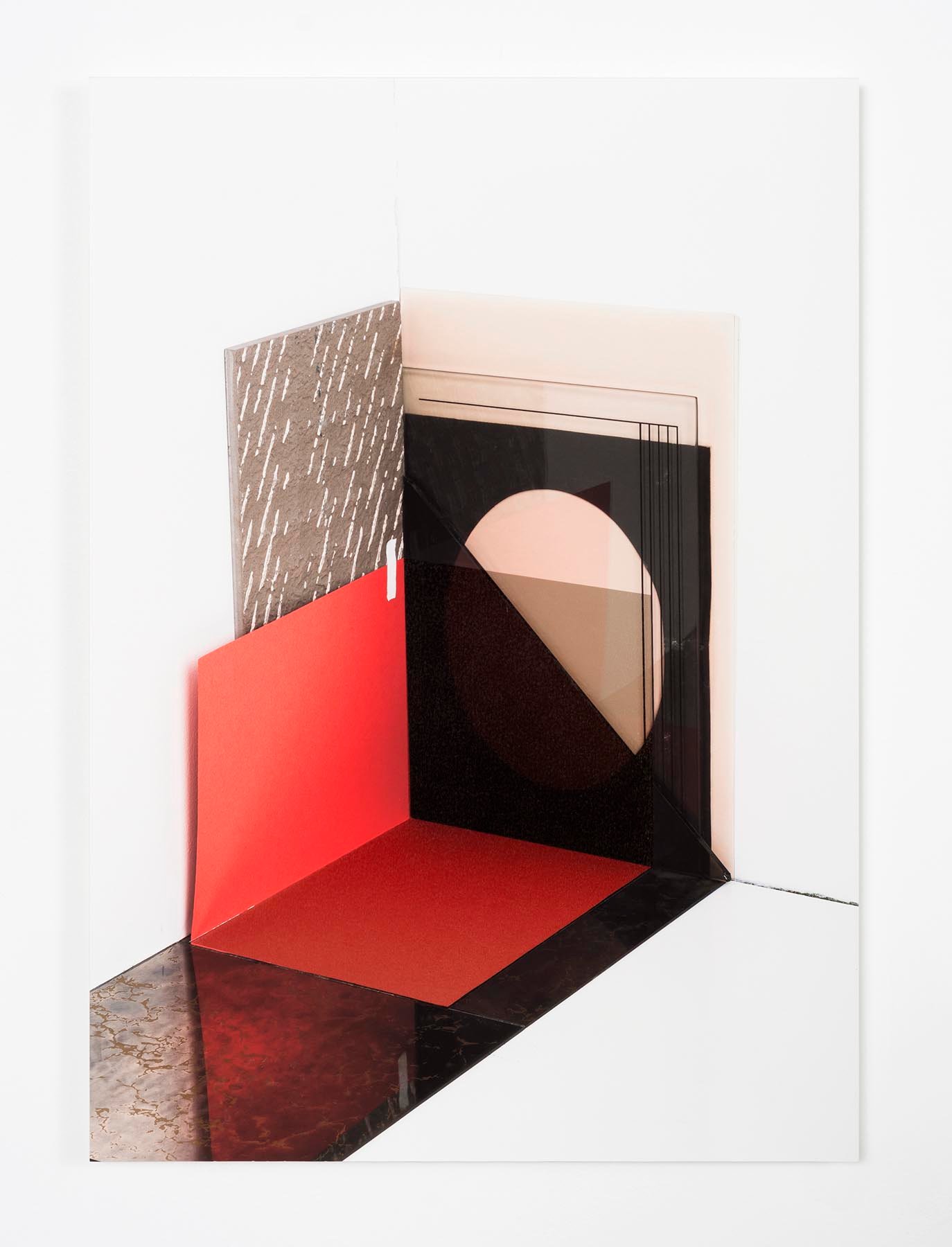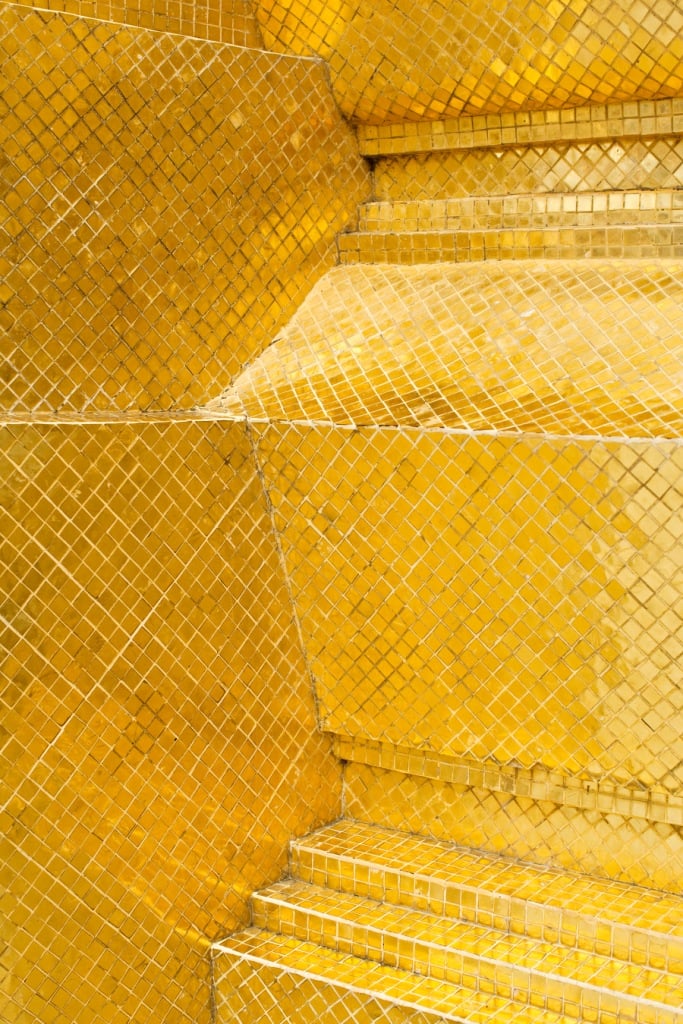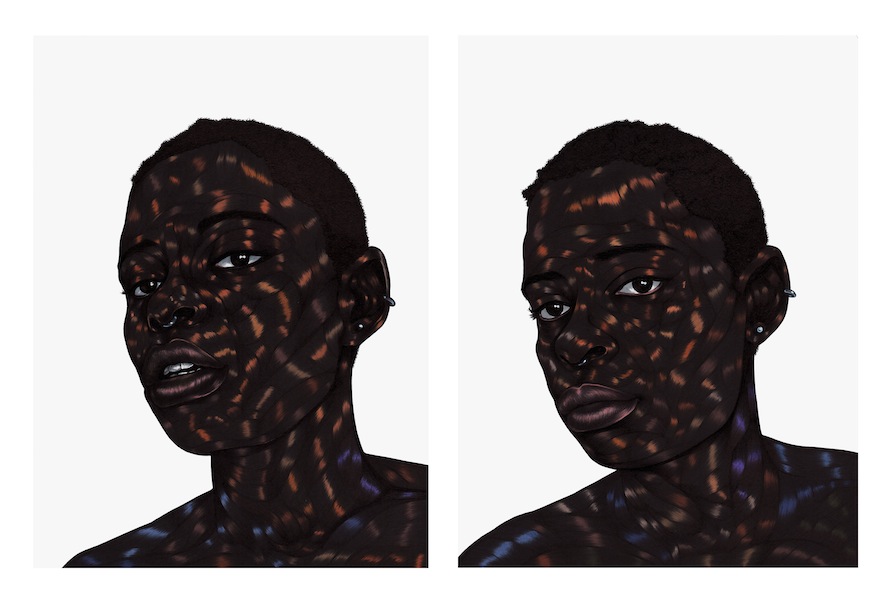
© » KADIST
Natan Lawson
Untitled (Bubbles) by Natan Lawson is produced by a marker with a ball-bearing tip, which is drained and refilled with a new color of acrylic paint for each layer. Untitled (Bubbles) is the result of collaging layers of imagery in the computer, before sending coordinates to the plotter which renders it, with some manual intervention of the canvas. Lawson thinks of the process as related to a computerized jacquard loom, where colors are woven and layered.

© » KADIST
James Collins
These two large format untitled paintings by James Collins feature the artist’s hallmark technique, which transforms abstraction into an optical illusion that creates dimension, space, and mass. These particular paintings expand on the optical illusion referred to as a moiré pattern. Moiré (or fringe patterns as they are also called) are known in mathematics, physics, and art as a type of interference pattern that can be produced when a partially opaque ruled pattern with transparent gaps is overlaid on another similar pattern.

© » KADIST
Jennifer West
This work was filmed on the shores of Jelly Bowl beach in Carpinteria, California, after Jennifer West was taken by the sight of a coastal family home owned by surfer Andy Perry. After conversing with Perry, spending time in the site, and engaging with several other locals, West wanted to produce a film that documented this idyllic Californian lifestyle and that embodied the sense of joy, warmth and nostalgia that multiple generations of surfers and their families had shared in this site. In the footage we see a couple of silhouettes wrapped up in blankets as they watch their beloved ones surfing at dawn—including surfers Andy Perry, and siblings Makela, Alana and Zach Moore.

© » KADIST
Zhang Zhenyu
In DUST 171217 Zhang Zhenyu uses fragments of dust collected across the city, and then creates dark abstract paintings, repetitively gluing the material to the canvas, applying up to 30 or 100 layers and sanding until he arrives at a smooth surface. The result is a reflective surface, an abstract object in which the viewer can see themselves staring back. The project began in 2014 and reflects a rampant process of modernization in his native China.

© » KADIST
Gaëlle Choisne
The average human has approximately 2 squared meters of skin. Deployed in space, suspended by small gold-plated chains, this skin is a recording tissue, a sensitive surface. The work is a result of a series of experiments with silicone and surfaces on which the artist transfers images.

© » KADIST
Shen Yuan
Through a seemingly haphazard layering of glass and porcelain, Dérive is part of a larger installation series that address borders and displacement. Sheets of glass and porcelain, two transformational materials of alchemy, are stacked loosely in the shape of melting glaciers that places humans, animals, and nature in the same ecosystem. Migrations of one population into another and the subsequent displacement is emphasized in sharp, jagged edges of the transparent glass—phantasmagoric dreams of a distant place—the migration of not simply physical bodies but also that of political opinions and thoughts.

© » KADIST
Toyin Ojih Odutola
Drawing & Print (Drawing & Print)
As she traces the same shape again and again, Ojih Odutola’s lines become darker and deeper, sometimes pushed to the point where their blackness becomes luminous. Set against a blank white background, as in Untitled (2015), Ojih Odutola’s figures are stark, resolute in their darkness. The surface of her subject’s skin becomes ribbon-like, lines weaving across the contours of their head and neck.

© » KADIST
Amol k Patil
The title of the performance video work Impression by Amol k Patil refers to an Indian tradition. During a Hindu or Muslim weddings, all the inhabitants of the chawl (very modest buildings) cover their chests, arms, and feet with henna. For this work the artist covered his chest with temporary henna tattoos before applying Fervicol, a synthetic resin adhesive.

© » KADIST
Christina Quarles
The title of the painting refers to the fact that the figure’s behind is raised upwards and the face is found at the bottom of the painting, thus inverting the way in which people are normally seen. Bottom’s up is also a pun, a nod to the English toast. Quarles draws on a number of sources of inspiration, including comic book imagery, the influence of which sits alongside elements of her practice informed by life drawing classes.

© » KADIST
Julia Rommel
On the artwork, Rommel states: “I was reading Jonathan Franzen’s new novel Purity, where they take a lot of walks through the jungle in Uruguay, or Paraguay, I can’t remember. One of the characters takes a walk and jumps off a cliff; it’s kind of dark. The painting reminded me of a long, dark, and very serious walks in beautiful places.” With references to Howard Hodgkin in the incorporation of the stretcher into the painting and certain kinds of mark making, to Matisse’s cut outs and to the history of Cubist collage, Rommel has created a dreamy oeuvre that manifests her strong conceptual interest in process and unmapped journeys.

© » KADIST
Phillip Maisel
While his works can function as abstract, they are very much rooted in physicality and the possibilities that are inherent in the materials themselves. Elements used in various stages of photographic processes (color filters, glassine, and prints themselves) are integrated back into the artwork either as part of the sculpture or as collage elements that are later added to the print. In some of the works, Maisel cuts into the prints themselves.

© » KADIST
Chris Wiley
Architectural details become abstracted renderings in Chris Wiley’s inkjet prints 11 and 20 (both 2012). In photographing seemingly mundane images of doorways and walls, Wiley collapses the viewer’s experience of inhabiting space by foregrounding features that we all too often miss in our built environment: the peeling white paint on a Corinthian column or the rusty studs on a blue door.

© » KADIST
Chris Wiley
Architectural details become abstracted renderings in Chris Wiley’s inkjet prints 11 and 20 (both 2012). In photographing seemingly mundane images of doorways and walls, Wiley collapses the viewer’s experience of inhabiting space by foregrounding features that we all too often miss in our built environment: the peeling white paint on a Corinthian column or the rusty studs on a blue door.

© » KADIST
Yang Xinguang
Although seemingly unadorned at first glance, Yang Xinguang’s sculptural work Phenomena (2009) employs minimalist aesthetics as a means of gesturing towards the various commonalities and conflicts between civilization and the natural world. Comprised of rudimentary planks of wood hammered together into a rectangular form, Yang’s work uses reclaimed materials from everyday life and seems deliberately in conversation with Arte Povera, the art movement that originated in Italy during the late 1960s where practitioners produced art from found and common materials as an act of resistance against the decided commercialization of the art world through market economies. Yang, by extension, pays close attention to his materials in attempt to release the forms within them rather than impose his own.
Chris Wiley
- location: New York, New York
- year born: 1981
- gender: male
- nationality: British
Natan Lawson
Producing hybrid artworks at the intersection of drawing and painting, Natan Lawson’s work exists in between hand-made and computer-processed...
Yang Xinguang
- location: Beijing, China
- year born: 1980
- gender: male
- nationality: Chinese
- home town: Hunan Province, China
Zhang Zhenyu
Zhang Zhenyu’s practice is at once conceptual and material, best-known for his dust paintings series, repurposing found matter, transforming waste dust into a highly polished image, his work is a reflection upon the trace elements of urbanization and development...
Jennifer West
Based in Los Angeles, Jennifer West is known for her work with film, not only through creating moving images and photographs, but for her exploration of the materiality of the film itself...
Toyin Ojih Odutola
Though born in Nigeria, artist Toyin Ojih Odutola was raised largely in the United States, living in Alabama, California, and now New York...
Christina Quarles
Christina Quarles’ work is concerned with the female body...
Shen Yuan
Shen Yuan studied Chinese painting at the Zhejiang Academy of Fine Arts as the first group of students admitted after the Cultural Revolution...
Julia Rommel
Julia Rommel (b...
Phillip Maisel
- location: San Francisco, California
- year born: 1981
- gender: male
- nationality: American
- home town: Chicago, Illinois
Amol k Patil
Interested in vernacular theater and performance, Amol k Patil works within family tradition: his grandfather was an interpreter and a poet (Powada Shahir, a troubadour telling epic stories as he went from one village to another), and his father was an avant-garde playwright, who addressed issues, such as the devastating effects of immigration and its traumas through absurd situations in his plays...
James Collins
James Collins works with acrylic and oil to create the illusion of dimensionality in highly graphic paintings...
-
2000-2009
Yang Xinguang
2009Although seemingly unadorned at first glance, Yang Xinguang’s sculptural work Phenomena (2009) employs minimalist aesthetics as a means of gesturing towards the various commonalities and conflicts between civilization and the natural world...
-
2010-2019
Jennifer West
2011This work was filmed on the shores of Jelly Bowl beach in Carpinteria, California, after Jennifer West was taken by the sight of a coastal family home owned by surfer Andy Perry...
Amol k Patil
2012The title of the performance video work Impression by Amol k Patil refers to an Indian tradition...
Chris Wiley
2012Architectural details become abstracted renderings in Chris Wiley’s inkjet prints 11 and 20 (both 2012)...
Chris Wiley
2012Architectural details become abstracted renderings in Chris Wiley’s inkjet prints 11 and 20 (both 2012)...
James Collins
2013These two large format untitled paintings by James Collins feature the artist’s hallmark technique, which transforms abstraction into an optical illusion that creates dimension, space, and mass...
Toyin Ojih Odutola
Drawing & Print
2015(Drawing & Print) As she traces the same shape again and again, Ojih Odutola’s lines become darker and deeper, sometimes pushed to the point where their blackness becomes luminous...
Julia Rommel
2015On the artwork, Rommel states: “I was reading Jonathan Franzen’s new novel Purity, where they take a lot of walks through the jungle in Uruguay, or Paraguay, I can’t remember...
Phillip Maisel
2015While his works can function as abstract, they are very much rooted in physicality and the possibilities that are inherent in the materials themselves...
Zhang Zhenyu
2018In DUST 171217 Zhang Zhenyu uses fragments of dust collected across the city, and then creates dark abstract paintings, repetitively gluing the material to the canvas, applying up to 30 or 100 layers and sanding until he arrives at a smooth surface...
Christina Quarles
2018The title of the painting refers to the fact that the figure’s behind is raised upwards and the face is found at the bottom of the painting, thus inverting the way in which people are normally seen...
